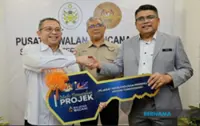Uniformed personnel from various authorities carrying out the rescue simulation at Nadma training ground in Puchong, Selangor. — Photos: GLENN GUAN/The Star
ON TOP of the remnants of a collapsed structure, several men in uniform sifted through the rubble with a palpable sense of urgency about them.
Soon, a team of medical personnel rushed to the site carrying a stretcher to place a body extricated from the wreckage.





